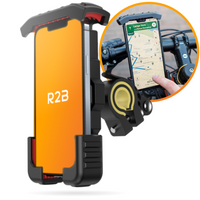No Products in the Cart

Installing a Screen Protector: A Simple Step-by-Step Guide
Time to read 3 min
Time to read 3 min
Welcome to our practical guide where we answer the question "how to apply a screen protector?" - whether it is tempered glass or a plastic screen protector. The process of applying this protective layer may seem simple, but it requires attention to detail to ensure that your screen remains free of tiny dust particles, fingerprints and annoying air bubbles. So let's start applying your screen protector in the best and most effective way.
Table of contents:
Today, tempered glass screen protectors are the most common choice for smartphone users looking for reliable protection for their screen. Due to their popularity and the superior protection they provide, in this blog we will focus on how to apply a tempered glass screen protector. It is important to emphasize that while these protectors are effective at preventing scratches and cracks, their non-flexible nature can make them a bit more difficult to apply. This makes an accurate and careful step-by-step plan all the more important. By following the correct techniques, we ensure that your screen protector fits your screen perfectly, preserving the functionality and appearance of your phone. The necessary items are almost always supplied when purchasing a screen protector. So let's start with the detailed steps on how to properly apply a tempered glass screen protector.
Are you still looking for a good screen protector? Then take a look at our top 5 below!
Start by creating a dust-free environment by cleaning a flat area of a table. This ensures that no dirt or dust particles get on your screen or screen protector. Once your workspace is ready, wash your hands thoroughly to remove fingerprints and oils, which is essential for clean and effective installation of the screen protector on your smartphone.
Step 2: Cleaning the Phone Screen
Thoroughly cleaning your screen is essential. Start with the included alcohol wipe ("WET") to remove dirt and fingerprints. Then use the dry cloth ("DRY") to dry the screen. If present, use the dust absorber to remove the last dust particles by sticking it to the screen and removing it again. This ensures that your phone is clean and therefore the screen protector will stick better.
Now that your screen is clean and ready, it's time for step 3: removing the protective film from the screen protector. This film protects the adhesive side of the screen protector against dirt and dust during the production and packaging process. Look for a tab or sticker, often labeled with a number or an instruction, to easily remove the film. Do this carefully and be careful not to touch the screen protector with your fingers to avoid getting fingerprints or dust on the adhesive surface.
Step 4: Position the screen protector
The fifth step in the process is perhaps the most crucial: accurately positioning and applying the screen protector to your phone. Start by gently holding the screen protector by the edges, paying extra attention to ensuring it is aligned correctly. Make sure that the cutouts for the camera and other sensors match exactly with the corresponding parts on your phone. The goal is to place the protector perfectly centered and flush with all edges of the screen.
Once you're sure everything is aligned properly, slowly lower the screen protector onto the screen. It is recommended that you start from one side – the bottom or the top – and carefully lay down the screen protector, paying attention to the adhesive bond to the screen.
Step 5: Remove any air bubbles
Small air bubbles may form under the protector during this process. In that case, use a plastic card or a special tool provided to gently push these bubbles to the nearest edge. It is important to proceed carefully to avoid scratches on the screen protector.
TIP: Apply screen protector with adhesive tape
A clever trick for accurately applying your screen protector is to use adhesive tape. Attach the protector to one side of your phone as a hinge with adhesive tape, clean your screen, and then fold the protector straight onto the screen.
Applying screen protector with mounting frame:
An innovative option is also available on the screen protector market: screen protectors with a mounting frame . With these frames you ensure that you apply the screen protector properly centered. The frame helps with accurate positioning of the protector, making application easier and faster. This is a great choice for those who find it difficult to manually straighten screen protectors. A mounting frame greatly simplifies the process of protecting your screen.
Hopefully you have found this blog helpful on how best to install a screen protector. Are you still looking for a good screen protector? Then view the entire range of screen protectors on Bol.com here!

